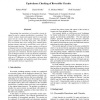Free Online Productivity Tools
i2Speak
i2Symbol
i2OCR
iTex2Img
iWeb2Print
iWeb2Shot
i2Type
iPdf2Split
iPdf2Merge
i2Bopomofo
i2Arabic
i2Style
i2Image
i2PDF
iLatex2Rtf
Sci2ools
ISMVL
2009
IEEE
2009
IEEE
Equivalence Checking of Reversible Circuits
Determining the equivalence of reversible circuits designed to meet a common specification is considered. The circuits’ primary inputs and outputs must be in pure logic states but the circuits may include elementary quantum gates in addition to reversible logic gates. The specification can include don’t-cares arising from constant inputs, garbage outputs, and total or partial don’t-cares in the underlying target function. The paper explores well-known techniques from irreversible equivalence checking and how they can be applied in the domain of reversible circuits. Two approaches are considered. The first employs decision diagram techniques and the second uses Boolean satisfiability. Experimental results show that for both methods, circuits with up to 27,000 gates, as well as adders with more than 100 inputs and outputs, are handled in under three minutes with reasonable memory requirements.
Artificial Intelligence | Elementary Quantum Gates | ISMVL 2009 | Reversible Circuits | Reversible Logic Gates |
| Added | 24 May 2010 |
| Updated | 24 May 2010 |
| Type | Conference |
| Year | 2009 |
| Where | ISMVL |
| Authors | Robert Wille, Daniel Große, D. Michael Miller, Rolf Drechsler |
Comments (0)

